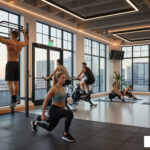Why Spinning Classes Are Taking the Fitness World by Storm
What are spinning classes exactly? They are instructor-led group workouts on stationary bikes, combining cardiovascular exercise with motivating music and coaching. These high-energy sessions typically last 45-60 minutes and simulate outdoor cycling through various terrains and intensities.
Quick Answer:
- Format: Group fitness class on stationary bikes with music and instructor guidance
- Duration: 30-60 minutes typically
- Intensity: Adjustable – you control your own resistance and speed
- Benefits: Burns 350-600 calories, low-impact on joints, builds leg strength
- Suitable for: All fitness levels from complete beginners to athletes
If you’ve ever wondered why spinning has become such a popular workout choice, the answer lies in its perfect combination of effectiveness and accessibility. These classes offer a low-impact alternative to running that’s easier on your knees and joints, while still delivering an intense cardiovascular workout that can burn between 350-600 calories in a single session.
The beauty of spinning lies in its adaptability. Whether you’re just starting your fitness journey or you’re an experienced athlete, you control your own intensity by adjusting the bike’s resistance. This means you can work at your own pace while still benefiting from the energy and motivation of a group setting.
Research shows that after just six weeks of spinning classes, participants experienced significant improvements in fitness, leg strength, blood pressure, and fat mass. The social aspect also provides mental health benefits, with group exercise linked to maintaining cognitive health.
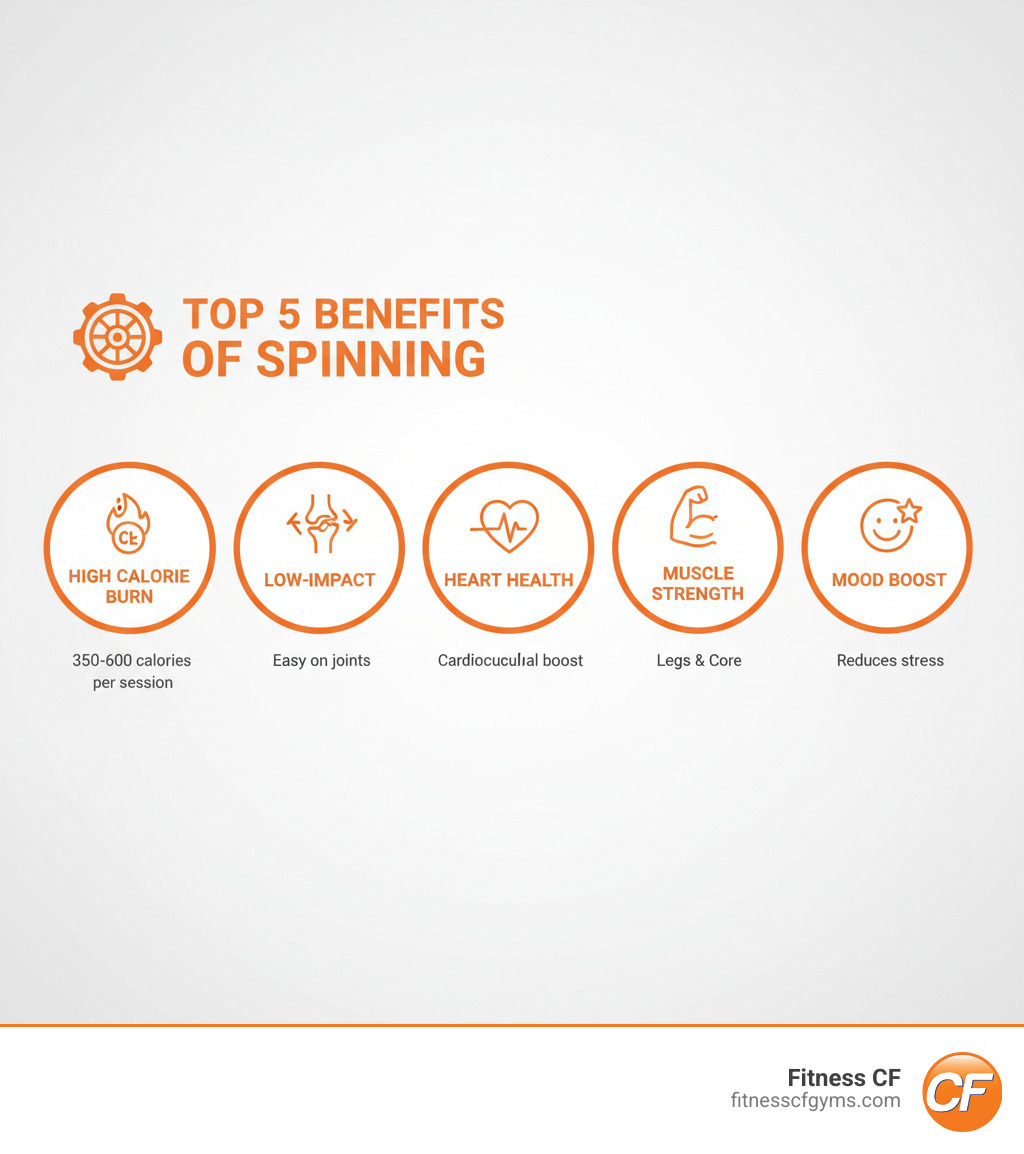
So, What Are Spinning Classes and Why Are They So Popular?
Picture a dimly lit room filled with stationary bikes, energizing music, and an enthusiastic instructor ready to take you on a virtual journey through hills and sprints. This is what are spinning classes are all about—an immersive indoor cycling experience that has captured the hearts of fitness enthusiasts everywhere.
They are instructor-led group workouts on specially designed stationary bikes that combine high-energy music with motivational coaching. These aren’t average stationary bike sessions; they’re choreographed rides that simulate outdoor cycling, complete with hill climbs, sprint intervals, and recovery periods.
The magic happens when you combine the physical challenge with group energy. There’s something incredibly motivating about riding alongside others. According to scientific research on calories burned, a typical spinning session can torch between 350-600 calories in just 30-45 minutes, making it a highly efficient workout.
But the popularity goes deeper than calorie burn. These classes offer a full-body workout that builds cardiovascular endurance and muscular strength, all while being gentle on your joints. This balance of intensity and accessibility has made spinning a go-to choice for people of all fitness levels.
The social aspect can’t be overlooked. There’s real power in group motivation. Research on the benefits of group training classes shows that this community atmosphere makes workouts more enjoyable and can lead to better long-term commitment.
The Physical Health Benefits of Indoor Cycling
Spinning delivers on multiple fronts for physical health. Your cardiovascular health gets a major boost as your heart works to pump blood to your muscles. Regular sessions strengthen your heart, improve endurance, and build aerobic capacity that makes daily activities feel easier.
Every pedal stroke works your quadriceps, hamstrings, and glutes, while your core muscles stay engaged to maintain proper posture. It’s a comprehensive lower-body and core workout.
What makes spinning particularly appealing is its low-impact nature. Unlike running, spinning is incredibly joint-friendly because your feet stay on the pedals, eliminating harsh impact. This makes it an excellent alternative to running for people with joint concerns.
Studies have shown that regular spinning can lead to improved blood pressure, better cholesterol levels, and significant fat mass reduction. It also helps build your aerobic capacity—your body’s ability to use oxygen efficiently—which improves every aspect of your daily life.
Mental and Social Perks of a Group Workout
The mental health benefits of spinning are just as powerful as the physical ones. Channeling stress into pedal strokes is uniquely therapeutic. As you push through challenges, your body releases a flood of endorphins, natural mood-boosting chemicals that create what many call the “spinner’s high.”
This endorphin release provides lasting stress relief and can significantly improve your mood. For many, spinning sessions serve as a mental release from daily pressures, offering a focused outlet to push through mental barriers and emerge feeling accomplished.
The community atmosphere in spinning classes creates something special. Working hard together and sharing challenges and victories forms natural bonds. This shared sense of accomplishment is incredibly powerful for building confidence.
Research shows that socialization through group exercise is linked to maintaining cognitive health as we age. The combination of physical challenge, social interaction, and mental focus helps build not just physical strength, but mental toughness too. Overcoming mental barriers in a supportive group setting makes it easier to silence self-doubt and find your true capabilities.
Your First Ride: What to Expect and How to Prepare
Walking into your first spinning class can be exciting. The dimly lit studio, energizing music, and rows of sleek stationary bikes create an electric, motivating atmosphere. Don’t be intimidated; that energy is pure motivation.
Your instructor will be your guide, offering motivational coaching and clear cues on when to adjust resistance, change your pace, or tackle a climb. The music isn’t just background noise; it’s the heartbeat of the workout, helping you find your rhythm.
The most important part of your first class happens before you start pedaling. Arriving early (10-15 minutes) gives you time to meet the instructor and get familiar with the bike without feeling rushed.
Your instructor will help with the crucial bike setup. They’ll show you how to adjust your saddle height, position your handlebars, and explain how the resistance knob works. A proper setup is the foundation for a safe and comfortable workout.
Once the class starts, you’ll begin a journey that includes a warm-up, a main workout with sprints and climbs, and a cool-down with stretching. Your legs might feel like jelly afterward, and some saddle soreness is normal. This usually disappears after a few sessions as your body adapts.
For more detailed insights, check out this comprehensive guide on What to Expect From Your First Spinning Class.
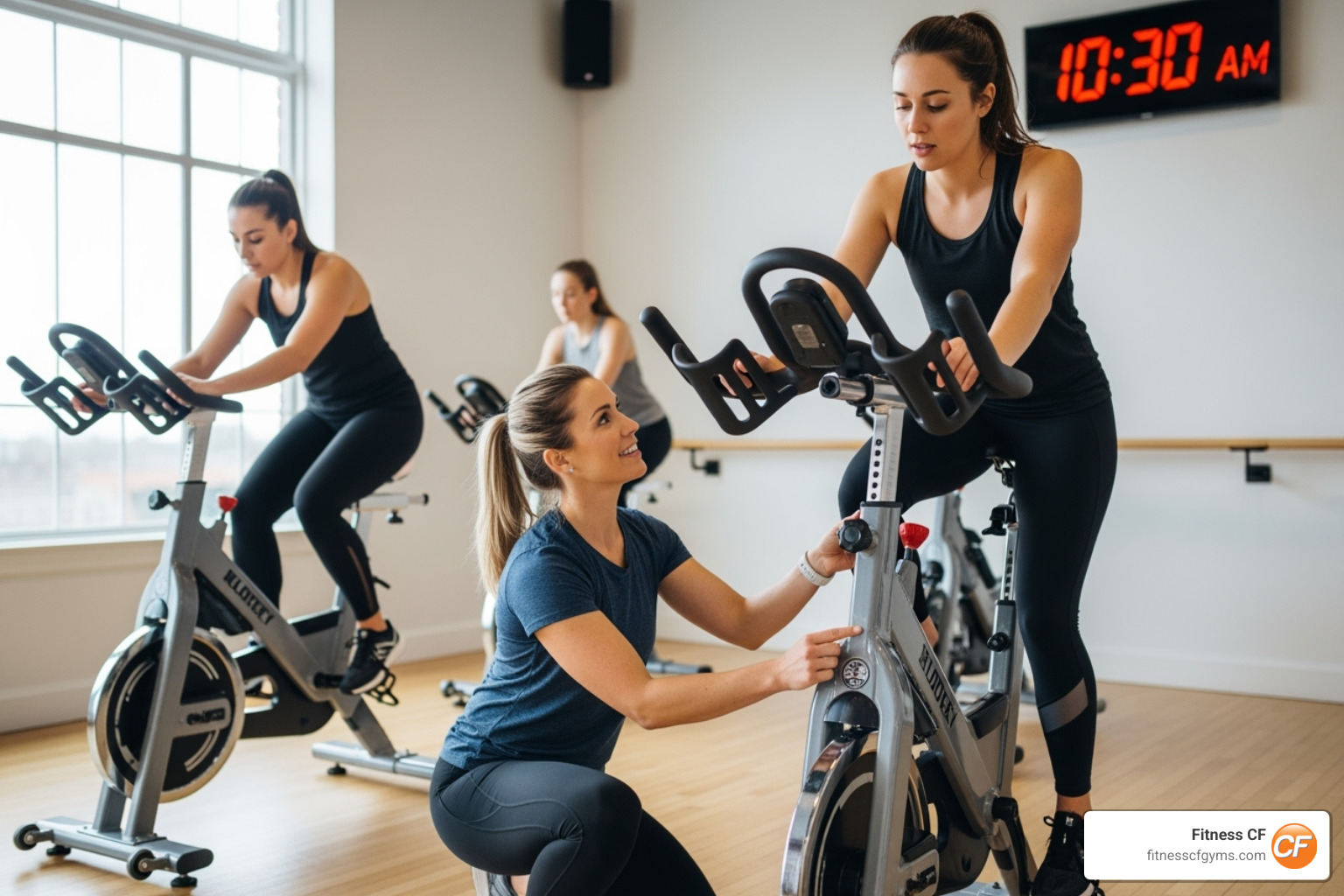
A Beginner’s Guide to what are spinning classes
Spinning classes are designed for everyone, so no experience needed is the reality. You are always in control of your workout intensity. While the instructor guides you, you decide how much resistance to add and how fast to pedal. Go at your own pace is the secret to enjoying your first class.
Listening to your body is key. If you feel you need to slow down or reduce resistance, do it. Your body is adapting to a new exercise, so be patient with it.
Be prepared for saddle soreness. It’s a normal experience for beginners, and the discomfort typically fades after two or three classes as your body adjusts.
It’s not a competition. Your only focus should be on your own effort. Showing up is a victory in itself. Trust your instructor’s guidance; they are there to help you succeed.
Essential Items for Your First Class
Bringing the right gear ensures maximum comfort and enjoyment.
- Water bottle: Hydration is essential for maintaining energy. You will sweat a lot.
- Towel: A small workout towel will be your best friend for wiping away sweat.
- Breathable clothing: Choose workout clothes that move with you. Form-fitting pants or shorts are important, as loose clothing can get caught in the bike’s moving parts.
- Athletic shoes: Sturdy, flat-soled athletic shoes work well for your first few classes. Later, you might consider cycling shoes with cleats for better pedaling efficiency.
- Optional padded shorts: These can be a game-changer for beginners concerned about saddle comfort.
Understanding the Ride: Class Structures and Movements
A spinning class is a structured, 45-60 minute fitness adventure on a simulated bike ride. The time flies by as you move through different phases of the workout.
Every ride begins with a warm-up to loosen your muscles and gradually raise your heart rate. This prepares your body for the main workout set, where your instructor guides you through a variety of challenges like heart-pounding sprints, tough hill climbs with heavy resistance, and dynamic jumps (moving between sitting and standing).
The cool-down is just as crucial as the main workout. Your heart rate gradually returns to normal, and you’ll finish with essential stretching to aid muscle recovery and improve flexibility.
The music is integral to the experience. Instructors carefully select songs to match each segment—upbeat tracks for sprints and steady rhythms for climbs—to keep you motivated.
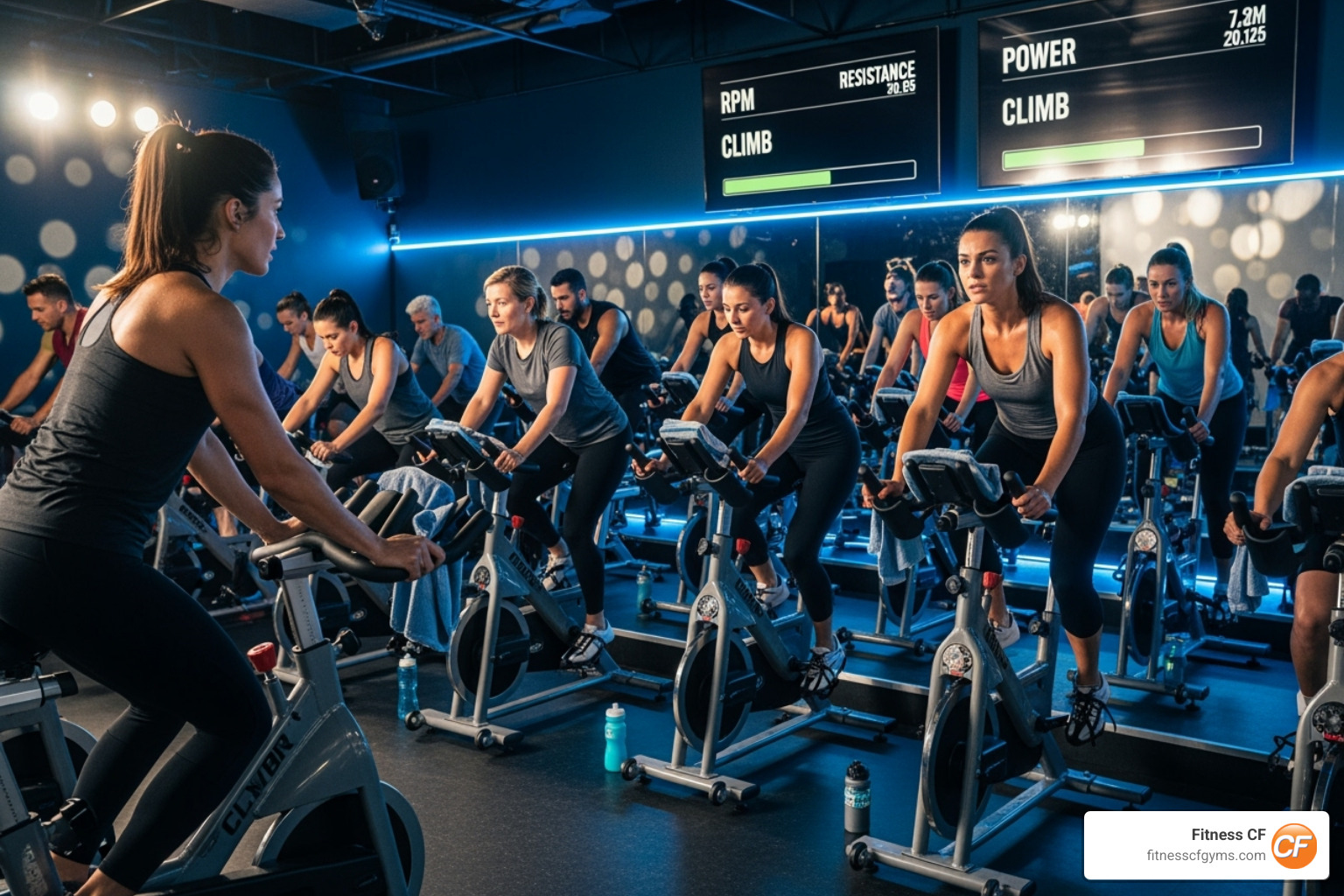
Common Class Types and Movements
When people ask “what are spinning classes” like, the answer is wonderfully varied. You’ll find different styles to keep workouts exciting. Some classes are rhythm-based, where you pedal to the music, while others are strength-focused, emphasizing heavy resistance. You might also find endurance rides that challenge your stamina.
Mastering five fundamental movements is key to spinning:
-
Seated Flat: Your base position, simulating a level road with moderate resistance. Hands are centered on the handlebars.
-
Standing Flat (Running): Up out of the saddle with lighter resistance and a brisk pace. Hands move to a wider position for control.
-
Jumps: Quick transitions between sitting and standing that spike your heart rate and add intensity.
-
Seated Climbs: In the saddle with heavy resistance, forcing you to pedal with power at a slower pace.
-
Standing Climbs: Out of the saddle with heavy resistance, using your body weight to drive the pedals. This builds incredible strength in your quadriceps, hamstrings, and glutes.
Throughout every movement, you’ll be adjusting resistance to match the simulated terrain your instructor describes. This control is what transforms a simple bike ride into an effective workout.
Health, Safety, and Getting the Most Out Of Your Workout
To make what are spinning classes both safe and effective, it’s important to prioritize proper form and safety. While spinning is wonderfully low-impact, understanding biomechanics is key to preventing injury and maximizing your results.
Proper bike setup isn’t just about comfort—it’s about injury prevention. When your bike fits correctly, every pedal stroke is more efficient, engaging the right muscles and protecting your body from strain.
Hydration is absolutely crucial. Your body works hard during these high-intensity sessions, and staying hydrated helps maintain energy and prevents dizziness. Be sure to drink water before, during, and after class.
One of the most important lessons for new riders is listening to your body. Spinning should be challenging, but it should never cause sharp pain. Muscle fatigue is different from a pain signal. Don’t feel pressured to match the intensity of others—your workout is your own.
Recovery plays a huge role in fitness progress. Overtraining can lead to burnout and increased injury risk. Balance intense spinning workouts with adequate rest to allow muscles to repair and grow stronger.
The NHS physical activity guidelines recommend at least 150 minutes of moderate or 75 minutes of vigorous activity per week. Spinning is an efficient way to meet these targets.
Look for certified instructors who can guide you safely and offer modifications. Before starting any new fitness routine, especially with pre-existing health conditions, it’s wise to consult your healthcare provider.
Potential Risks and How to Avoid Them
Saddle soreness is the most common complaint from first-timers. This is normal and typically fades after a few classes as your body adapts. Padded cycling shorts can make a world of difference.
Lower back strain and knee pain are usually signs of an improper bike setup. An incorrect saddle height or handlebar position can cause your body to compensate in ways that lead to discomfort. Always take the time to ensure a proper bike fit.
Maintaining control of your bike is essential. Always keep some resistance on the flywheel. Pedaling with too little resistance at high speeds can cause the flywheel to “run away” with your legs, leading to a loss of control and potential injury.
Avoiding excessive bouncing is also crucial. If you’re bouncing in the saddle, it usually means you need to add more resistance for a smoother, more controlled pedal stroke.
Proper bike fit cannot be overstated. Your knee should have a slight bend (25-35%) at the bottom of the pedal stroke, and handlebars should be at a comfortable height. Getting this right ensures a safe and effective workout.
Frequently Asked Questions About Indoor Cycling
When considering a new workout like spinning, it’s natural to have questions. Here are answers to some of the most common ones about what are spinning classes.
How many calories can you burn in a spin class?
The calorie-burning potential of spinning is impressive. In a typical 45-minute class, you can burn anywhere from 350 to 600 calories, sometimes more.
This range depends on several factors, including your weight, class duration, and intensity level. The best part is that you’re in complete control of your calorie burn through the resistance you choose. Pushing harder during climbs and sprints will increase the burn, making spinning an effective tool for weight management.
The high-intensity interval training (HIIT) nature of many spin classes also means you’ll continue burning calories after the workout ends, a phenomenon known as the afterburn effect. For more detailed comparisons, scientific research on calories burned provides excellent data.
How often should I take a spin class?
For most people looking to improve their overall health, 2-3 spin classes per week is a great target. This frequency allows for both challenge and recovery.
This schedule aligns with health guidelines recommending 75 minutes of vigorous activity weekly. Since spinning is a vigorous workout, 2-3 sessions can efficiently meet these recommendations.
Balance is key for a sustainable fitness routine. Combine spinning with other forms of exercise, like strength training for the upper body or yoga for flexibility, to create a well-rounded approach.
If you’re new, start with one class per week to see how your body responds. As your fitness improves, you can gradually increase the frequency. Proper recovery is essential for avoiding burnout and injury.
For those just starting, this guide to the Best Fitness Classes for Beginners offers helpful insights.
What are spinning classes best for?
Spinning classes excel in multiple areas of fitness and wellness.
- Cardiovascular Fitness: Spinning is an incredible workout for your heart and lungs, building endurance that improves stamina in all daily activities.
- Low-Impact Training: It provides an intense cardio workout while being gentle on your joints, making it a great choice for those with joint concerns or recovering from injury.
- Weight Management: The high calorie burn, combined with building lean muscle, makes spinning an ideal workout for fat loss and weight management.
- Lower-Body Strength: Pedaling against resistance naturally develops strength in your quadriceps, hamstrings, glutes, and calves.
- Motivating Environment: The combination of music, instruction, and group energy makes exercise fun and sustainable, which is often the most valuable benefit for long-term success.
Start Your Indoor Cycling Journey Today
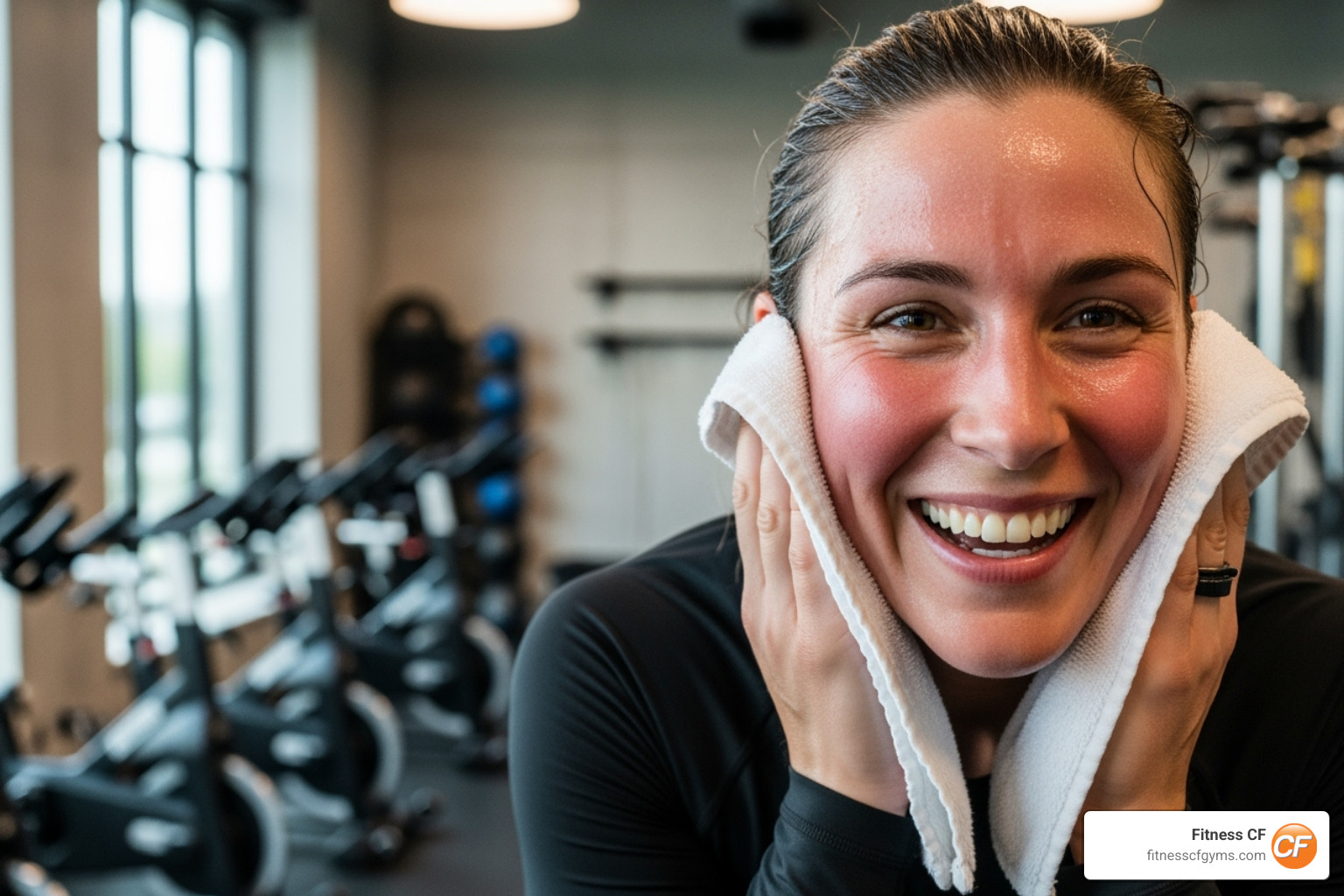
Now that you know what are spinning classes offer, you might feel excited about this new path to better health. Spinning represents a unique blend of effectiveness, accessibility, and pure enjoyment.
Think about it: where else can you burn up to 600 calories in under an hour while giving your joints a low-impact workout? The cardiovascular benefits strengthen your heart, while the resistance builds impressive lower-body power that carries over into daily life.
But perhaps the best thing about spinning is how it welcomes everyone. Whether you’re a beginner or a seasoned athlete, the bike adjusts to your needs. You control the resistance and pace. It’s not about competition; it’s about becoming a stronger, healthier version of yourself.
The mental benefits are just as powerful. The endorphin release during and after class is a natural mood booster that melts away stress and builds confidence. The community aspect creates connections and a collective energy that makes even the toughest workout feel achievable.
Starting your indoor cycling journey doesn’t require perfection—it just requires showing up. The supportive atmosphere means you’ll never feel alone. The combination of motivating music, expert instruction, and group energy creates an environment where positive change happens.
Ready to experience the incredible benefits of spinning for yourself? Finding the right class is the next step. Look for indoor cycling classes designed to challenge and inspire you, regardless of where you’re starting from.
Explore our Group Fitness Classes and take that first powerful pedal stroke toward a healthier, happier you. Your future self will thank you for it!




